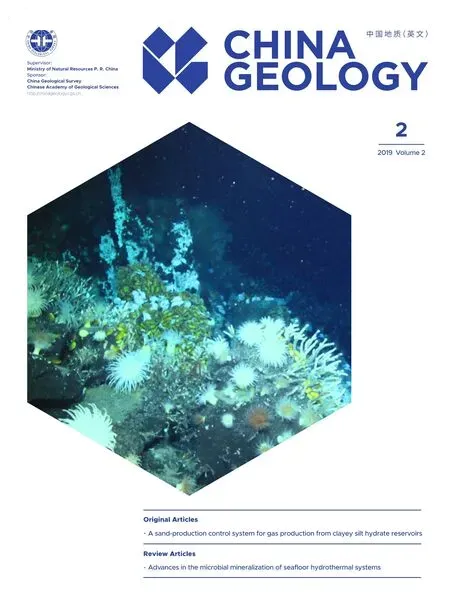First report of TSR origin minerals filled in anhydrite dissolved pores in southeastern Ordos Basin
Li-hong Liu , Chun-lin Wng, Xing-min Zho
a Oil & Gas Survey, China Geological Survey, Ministry of Natural Resources Beijing 100083, China
b School of Earth and Space Sciences, Peking University; Institute of Oil & Gas, Peking University, Beijing 100871, China
c MLR Key Laboratory of Metallogeny and Mineral Assessment, Institute of Mineral Resources, Chinese Academy of Geological Sciences, Beijing 100037, China
1. Objective
Yican 1 well, drilled in Southeastern Ordos Basin by Oil& Gas Survey, China Geological Survey in 2014 produced 3.7×104m3natural gas daily, which is the most productive well in the area by far. However, the reservoir quality is poor compared with those of Jingbian gas field in the middle of the Basin, which is mainly caused by the pores filling in karst reservoir. The minerals filled in karst pores in southeastern Ordos Basin is mainly calcite, which filled more than 90%anhydrite dissolved pores and resulted in the loss of the porosity, whereas in Jingbian gas field, the pores are mainly filled by dolomite of less than 70% remaining much reservoir space. Therefore, the pores filling composition and filling degree control the spatial distribution of the reservoir. It’s favorable to find reservoir to study the characteristics and the formation mechanism of pores filling minerals.
2. Methods
More than 22 core samples were taken from Yican1 well in Southeast of Ordos Basin from a range of depths (600-3200 m)and were examined petrographically. Petrographic studies were performed with an optical microscope and thin section which were stained to discriminate between calcite and dolomite. The filled minerals in pores and matrix dolomite were separated by microdrill to compare the isotope composition. Carbon isotope analysis of the filled minerals was performed using a laser sampling device linked to a conventional mass spectrometer. The authors calculated the homogenization temperature and salinity of the fluid inclusion in quartz, calcite and dolomite for comparison.
3. Results
The anhydrite dissolved pores are mainly filled with quartz, calcite, dolomite and pyrite et al. (Fig. 1). Through homogenization temperature and salinity analysis of the fluid inclusion, the homogenization temperature of quartz, calcite and dolomite filled in anhydrite dissolved pores is 113-154 °C,140-174 °C and 190-196 °C, respectively. The tempera- ture of dolomite precipitated is significantly higher than the maximum temperature of the strata, which may be affected by hydrothermal fluid. The salinity calculated from the freezing temperature in three minerals is all between 15.47% and 23.18%, which indicates that the minerals filled in pores are formed in high temperature and high salinity diagenetic fluid in buried condition. Theδ34S value varies from 10.50‰-24.00‰, average of 17.33‰, which shows the characteristics of TSR (Thermo-Chemical Sulfate Reduction)origin.

Fig. 1. Photomicrographs showing the minerals textures filled in anhydrite dissolved pores in Majiagou Formation of southeastern Ordos Basin. a,b- Calcite, dolomite and quartz mixture filled in anhydrite dissolved pores, Yican 1 well, 2641.4 m, member 1 of Majiagou Formation;c,d- Calcite, dolomite and quartz mixture filled in anhydrite dissolved pores, Yican 1 well, 2642 m, member 1of Majiagou Formation. Fluorescence photomicrograph of Fig. 1d showing finely crystalline dolomite with reservoir space in the bottom of anhydrite dissolved pores.
The carbon and oxygen isotope analysis result reveals that the averageδ13C value is -4.66‰ and averageδ18O value of filled minerals is -12.12‰ respectively; both values are significantly lower than those in corresponding dolomite,which is -1.84‰ and -8.47‰ respectively. The homogenization temperature and salinity result of the fluid inclusion suggest that the extreme lowδ13C value is caused by the organic carbon in deep buried strata, whereas the relative highδ18O value is caused by the high temperature of deep strata.
Previous studies considered that the anhydrite dissolved pores are filled in near surface environment as soon as the anhydrite is dissolved from meteoric water (Zhang JT et al.,2016). However, based on above analysis, the minerals filled in anhydrite dissolved pores in southeastern Ordos basin are mainly precipitated in buried condition. The basic principle is according to retrograde solubility model of carbonate, namely with the increasing of formation temperature, the carbonate mainly precipitates but not dissolves (Huang SJ et al., 2009).Since uplifted and erosion in Caledonian, the Ordovician stratum is buried continually until late Cretaceous (Fig. 2)(Ren ZL et al., 2017). The carbonate solubility decreases with the increasing of temperature in deep buried depth. The pore fluid becomes saturated with respect to minerals such as calcite and dolomite, which precipitate in the pores and cause the reservoir quality worse.

Fig. 2. Burial history diagram of Yican 1 well in southeastern Ordos Basin (modified from Ren ZL et al., 2017).
Besides, under the high temperature of deep buried condition, TSR occurred in the high salinity fluid, which caused the authigenic calcite precipitated with lowδ13C value and pyrite precipitated with highδ34S value (Fig. 1c, d). H+will be released when TSR occurred, which reduced the PH value of the strata fluid and facilitated the authigene quartz precipitated, which can interpret the closely connection of calcite and quartz in time and space.
4. Conclusion
Based on the above analysis, it can be concluded that the anhydrite dissolved pores are mainly filled in deep buried condition, where TSR provides CO2for calcite precipitation and H2S for the formation of pyrite, which is different from the diagenisis in meteoric water.
Acknowledgement
This research was supported by National Science Foundation of China (41802173).
- China Geology的其它文章
- The Key Laboratory of Coastal Wetland Biogeosciences
- Introduction to Key Laboratory of Gas Hydrate, Ministry of Natural Resources
- The Report of China Mineral Resource Reserves, 2018
- The Report of China Mineral Resource Exploration, 2018
- Discovery of Late Cretaceous-Paleocene faulted basins developed on the Yandang Low Uplift, East China Sea Shelf Basin
- Multiphase porphyry intrusions in the Sungun copper deposit, NW Iran: Evidence from SHRIMP zircon U-Pb dating

